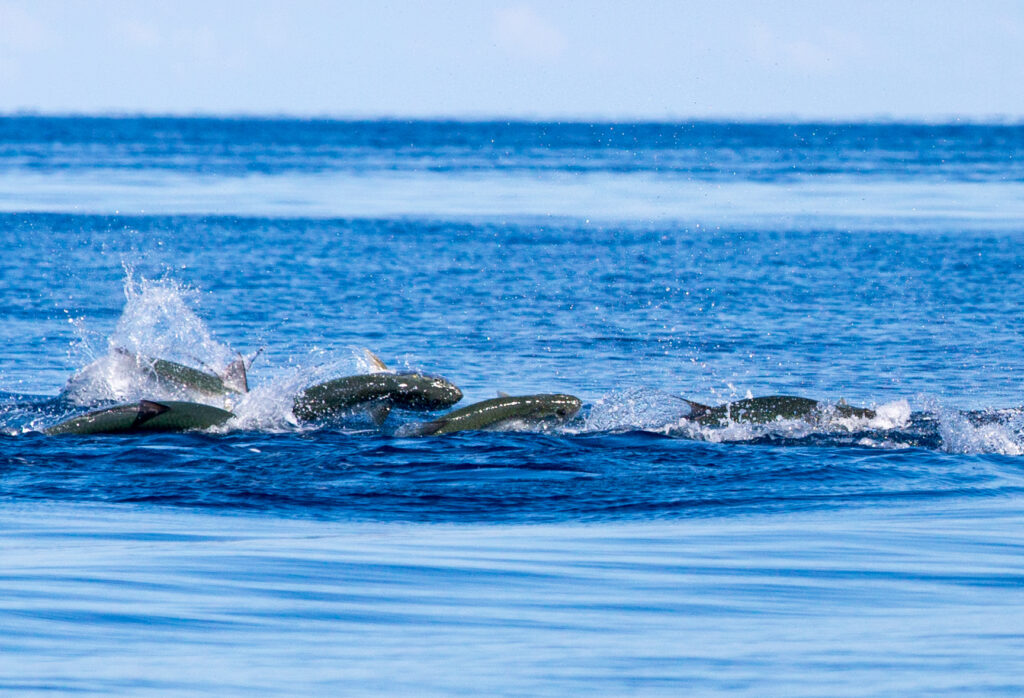Migrating tarpon in the Florida Keys. Photo: Dan Diez
Are you planning to attend BTT’s 7th International Science Symposium & Flats Expo November 4-5 at PGA National Resort in Palm Beach Gardens, Florida? Here are three presentations not to be missed! And if you haven’t registered yet, space is running out fast. You can join us at this triennial event sponsored by Costa Sunglasses by registering HERE. View the complete schedule HERE.
Actionable Science for Juvenile Habitat Conservation
November 4, 9:15 – 9:30 a.m.
JoEllen Wilson, BTT Juvenile Tarpon Habitat Program Manager
Coastal habitats are in decline due to development, altered water flows, excess nutrients, and contaminants impacting our waterways. These coastal habitats are essential to the juvenile life stage of flats species. Ultimately, without healthy coastal habitats, we don’t have healthy fisheries.
Unfortunately, traditional fisheries management still lacks habitat as a component of the management approach. This is no longer acceptable given the overwhelming evidence that degraded and depleted habitat has resounding impacts on our fisheries. BTT has begun to implement a framework, focusing on juvenile snook and tarpon, that can be used by fisheries management to include habitat. The first task is to identify productive vulnerable habitats followed by protecting locations that are natural and restoring locations that are degraded.
Working with our colleagues at Florida Fish & Wildlife Conservation Commission (FWC) in Southwest FL, we’ve identified that snook can be used as an umbrella species not only for other vulnerable prey species, but for specific productive habitats – mangrove tidal creeks. We’ve also worked with FWC to monitor juvenile sportfish populations and their prey species before and after habitat restoration, and preliminary results show that appropriately designed habitat restoration is a viable means to increase habitat function and juvenile sportfish productivity. By creating and implementing this framework, Florida can revolutionize the way fisheries and habitat are managed.
Hammering the Silver King: Quantifying Depredation and Spatial Overlap of Atlantic Tarpon by Hammerhead Sharks in a Florida Angling Hotspot
November 4, 1:45 – 2 p.m
Grace A. Casselberry, Department of Environmental Conservation, University of Massachusetts Amherst
Human activities, like recreational angling, are capable of altering the behavior of individual fish within populations and facilitate predation events, causing shifts in predator-prey dynamics and posing management challenges. The Atlantic tarpon (Megalops atlanticus) fishery in Florida is primarily catch-and-release, but fishing guides in the Florida Keys are increasingly reporting the loss of hooked tarpon to depredation, particularly by great hammerhead sharks (Sphyrna mokarran). Such interactions have the potential to impact both tarpon and hammerhead populations. Previous research of tarpon and hammerhead movements in the Florida Keys revealed that the Bahia Honda channel is an area of significant spatiotemporal overlap between the two species.
To better understand depredation in Bahia Honda, we used visual surveys to quantify depredation rates of tarpon by sharks and acoustic telemetry to examine spatial overlap between predator and prey. Seventeen great hammerheads were tagged with acoustic transmitters and color-coded cattle tags to aid in visual identification of individuals, and 200 tarpon were implanted with acoustic transmitters. Results from standardized visual observations of fishing activity in spring 2019 indicate ~15% of hooked tarpon suffer depredation mortality by great hammerhead sharks, and that water current direction and angling intensity contribute to depredation susceptibility. Moreover, analyses of movement patterns of both species indicate that hammerheads modify their space use in Bahia Honda channel with increasing tarpon presence. Movement data coupled with the visual survey data, will be the foundation for solutions to reduce depredation events, increasing tarpon survival and decreasing the potential for angler-shark conflict.
Crossing the Line: How Multi-Year Trends in the Movement Patterns of Atlantic Tarpon Indicate the Need for Cooperative Management in the Southeastern USA and Gulf Of Mexico
November 5, 11:30 a.m. – 12 p.m.
Dr. Lucas Griffin, Department of Environmental Conservation, University of Massachusetts Amherst
Within the Gulf of Mexico and southeastern USA, Atlantic tarpon (Megalops atlanticus) are emblematic of the mismatch between the spatial ecology and the management of migratory species. Relatively little is known about this purely recreational species that contributes to a fishery worth hundreds of millions of dollars. Here, relying on an extensive collaboration of institutional, state, federal, non-government organizations, and hundreds of recreational guides and anglers, we report on an ongoing tarpon acoustic telemetry project spanning the Gulf of Mexico and southeastern USA that began in 2016.
To date, nearly 200 tarpon have been surgically implanted with small acoustic transmitters with the objective to quantify the spatial ecology of tarpon for a wide size range of individuals and for multiple years. All mature tarpon with adequate tracking durations and detection histories displayed some level of migratory movements with distance varying among individuals, and individual tarpon used a wide range of habitats (e.g., rivers and estuaries, mangroves, open ocean) within a single year. In warmer months, many tarpon moved north to productive estuarine systems that represent putative foraging grounds (for mullet, menhaden, crustaceans), and then move southward when water temperatures begin to decrease. Further, many tarpon return southward to the Florida Keys during the early spring months likely to spawn. We report novel findings surrounding the seasonal occupancy patterns within the Florida Keys, including the timing of arrival and departure.
Ultimately, even some relatively small tarpon make considerable migrations (> 1000 km), providing critical insights related to habitat connectivity and the need for inter-state cooperation on fishing regulations. Inter-season repeatability of movement patterns among individual tarpon indicates a level of site fidelity to spawning, foraging, and overwintering grounds, that needs to be incorporated in management strategies. Integrating movement data into management should help to reduce risks placed on tarpon stock from impacts such as habitat destruction, depredation, harvest, and declines in important foraging prey stocks.




